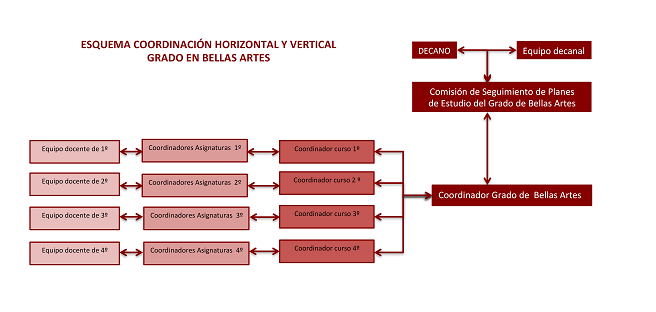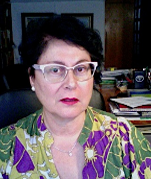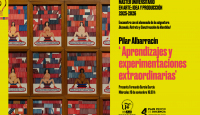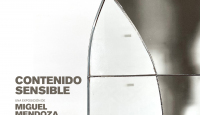General Information
The Faculty of Fine arts building is located in the center of the city, and has a long tradition in Seville. The Faculty of Fine Arts puts at your disposal the Bachelor of Fine Arts, which provides a solid base of general training around the artistic phenomenon, and is designed to offer the possibility to get to know and experience the problems related with art, both practically and reflectively. Its main purpose is to encourage the creativity through training that unifies tradition and modernity, in a wide and diversified offering of courses which has the most traditional disciplines (Painting, Sculpture, Drawing, Engraving...) and the most current approaches, linked to new imaging technologies (Videocreation, Photography, Design...) or linked with the interdisciplinary nature (Advertising Art, Performance, Facilities...), along with the reflective and investigating perspective (Art Criticism and Theory, Art History, Final Project...). On the basis of a comprehensive training, one can find a theoretical-practical training that develops personalized attention that promotes creativity and debates surrounding art and visual culture. All of these favour the development of autonomous artistic creation and strengthen one's own critical thinking.
Objectives
The Bachelor Degree has the basic purpose of training students to become future professionals of art, both in theoretical knowledge and practical experience of their creative activity.
The main objectives are:
1. To give the students the necessary tools for the integration of their knowledge in the autonomous creative process and/or interdisciplinary experience in a way that can develop their artistic training in all kinds of formats and cultural spaces.
2. To prepare the students for a professional artistic training that allows them to make a commitment to contemporary reality, as well as to receive the social recognition of their skills.
3. To train the graduates so that they can continue with their national or european postgraduate studies.
Specific Objectives:
1. The students acquire the capacity to identify and to understand problems through their practical experimentation, encouraging the perception and conceptualization processes of those aspects of susceptible reality that must be treated artistically.
2. The students acquire the capacity to develop the artistic creation process through the learning of different technologies, favouring the critical reflection of their own works and raising their awareness of the context in which it is held.
3. The students acquire knowledge about the problems other artist may have, as well as the solutions given by those professionals; the criteria used and why these are the chosen solutions.
4. The students acquire knowledge about the different functions art has acquired in relation with other socio-cultural contexts in which have been generated. They get to know the evolution of the different forms of expression, their interactions and mutual influences, and to understand how all these form the present and determine the future.
5. The students acquire knowledge about the structure of the cultural industry, as well as the location and configuration of the decision-making centres.
6. The students acquire the ability to elaborate strategies of artistic creation by means of the realization of individual projects or in groups, under the transformative power of art, as an active agent in the configuration of cultures.
7. The students acquire a training from the artistic experience that, as part of their knowledge, built an unifying basis of the different professional profiles of the graduates.
Cross-Cutting objectives:
1. To provide the students with knowledge about the necessary language to master the oral and written expression, and to learn a new language easily.
2. To train the students in the search of information, analysis, interpretation, synthesis and transmission.
3. To train the students to resolve problems in a creative and innovative way.
4. To make the students aware of cultural and environmental context.
5. To train the students for work and autonomous learning.
6. To train the students to acquire the necessary communicative skills in order to establish national and international contact networks.
Skills
The skills are related with creative experimentation, as well as theoretical reflection. They allude to the wide range of activities that surround art and the cultural industry.
G01. Basic knowledge in the artistic studies area, which is drawn from the premise of general secondary education, and supported by advanced texts book; it develops the proposal of the Bachelor of Fine Arts.
G02. Capacity to apply artistic knowledge to work interests or the students vocation in a professional way. Disposal of the skills that are usually portrayed through the elaboration and defence arguments, and the resolution of problems within the scope of Plastic Arts.
G03. Capacity to gather and interpret information (usually of artistic nature) to send out opinions that have a reflection about important topics related with society, sciences, or ethics.
G04. Capacity to transmit information, ideas, problems and solutions, in a written or verbal way, to an audience that might be specialized or not.
G05. After having developed the necessary learning skills, to continue with subsequent studies with a high level of autonomy.
G06. Capacity to use searching tools of bibliographic resources.
G07. Capacity to express oneself correctly in Spanish in an verbal and written way.
G08. Capacity to communicate in other important languages of the artistic field.
G09. Sensitivity to sociocultural and environmental problems, and those related to the conservation of the cultural heritage.
G10. Capacity to work in groups.
G12. Capacity to encourage the entrepreneurial spirit.
G13. Capacity to promote and guarantee the respect of the Human Rights and the universal accessibility principals, equality, democratic values, and the culture of peace.
E01. Capacity of Comprehension and the implementation of vocabulary, codes, and inherent concepts to the artistic work and to the conservation of it.
E02. Capacity to use different technical resources.
E03. Critic understanding of the aesthetic values, historical, anthropological evolution in relation with Art.
E04. Understanding and artistic application of the fundamentals of drawing, colour, and volume.
E05.Capacity to apply the materials and the appropriate procedures in the development of different artistic production processes.
E06. Capacity to symbolise and interpret the spaces and shapes through the artistic and technical language.
E07. Understanding of the tools and experimental methods in Art.
E08. Capacity to apply technological means to the artistic creation.
E09. Capacity of intellectual assimilation of the artists, theory and art discourses.
E10. Capacity of analytical reflection and self-criticism.
E11. Capacity to conceive and develop artistic projects through an empirical methodology.
E12. Knowledge about the production methods and experimentation with materials and artistic techniques.
E13. Capacity to contextualize a work of art in relation with the comprehension and valuation of the different Art discourses.
E14. Capacity to manage, to present in a proper way, and spread the artistic production.
E15. Knowledge about the national and international cultural institutions, artistic agents and the way they work.
E16. Capacity to interrelate different ways in the artistic creation process.
E17. Capacity to set up photography and video technologies in the different art forms.
E18. Capacity for the critic understanding of the performative dimension and the social influence of Art.
E19. Capacity to use the time and space dimensions of a work in a creative way.
E20. Capacity to depict graphically an artistic intervention project.
E21. Capacity to conception of artistic works in different creative procedures.
E22. Capacity for the adaptation of the different techniques and procedures to the personal artistic discourse.
E23. Capacity to experimentation and interrelation of the different procedures.
E24. Capacity to contextualize the artistic work in relation with the latest tendencies of the present Art practice.
E25. Capacity to underline the proper use of the knowledge acquires, abilities, and the skills acquired in the Bachelor.
E26. Capacity to the development of a creative project according to the artistic discourse.
E27. Capacity to produce and relate ideas within the creative process.
E28. Capacity of analytical (self) reflection and (self) critique in the artistic work.
E29. Heuristic capacity for the development of artistic and innovative strategies.
E30. Capacity to communicate and present ideas, and artistic project in a proper way.
E31. Capacity to interrelate different disciplines and to collaborate with professionals of different fields.
E32. Capacity to show clearly orally and in a written way the complex artistic problems and projects.
E33. Capacity to understand and value the artistic discourse in relation with the work.
ADDITIONAL INFORMATION: you can find more information in the next documents
Bachelor of Fine Art brochure. University of Seville
Students Guide of the University of Seville.
Plan of Studies
Report's verification of the Bachelor
Career opportunities
Fine Art graduates can perform activities in different professional areas:
- Idea person in the field of Plastic and Visual Arts (Plastic Artist and Visual Artist):-Drawing - Painting - Sculpture - Graphic Arts -
Photography - Animated films- Videos - Audiovisual Creation and Multimedia - Public Art - Intermediate Art - Net-art.
- Idea person in the field of Plastic Arts and Applied Visual Arts:-Illustration (for children, scientific, didactics, advertising, press, etc.)- Graphic Humour - Comic - Matte Painting - Concept-art - Layout and Story-Board for cinema - Creation of Video Games - Animation and Photography (advertising, documentary, cinematographic, etc.) - Artistic Production at cinema and TV - Mounting of Exhibits - Scenography - Ephemeral Architecture and Sculpture (amusement parks, parades, etc.) - Window Dressing - Decorating - Model Making - 3D Simulation - Sculptural and Anatomical Modeling for science (orthopaedics, legal medicine, and forensic medicine.
-Idea person in the field of Design (Designer): (later specialization in different professional aspects): Graphic Designer, Multimedia and Interaction Designer - Fashion Designer - Industrial Designer and Furniture Designer - Garden Designer and Landscaping Designer.
- Cultural Manager and Adviser:- Museum Management, Artistic Centres, Art Galleries and House of Culture - Event Organization and Cultural Activities - Exhibition Consulting and Exhibition Curatorship - Participation in Committees.
- Teacher in the non-formal artistic education scope:- Museum Pedagogical Bureau - Creation Workshops in institutions and public and private companies - Art Therapy Workshops - Educational Activities of cooperation to development.
- Teacher at the official education (through the Master of Teaching. Specialities: "Image, Design and Plastic Arts" or "Social Sciences").
- Professor at the official education, superior level:- Universities and public and private graduate school.
- Professional in other spheres related with Fine Arts:- Editor in artistic publication - Art Critic - Participation in interdisciplinary projects (engineering work, building, technological developments, manufacturing facilities, environmental consideration, spatial planning, etc.).
Horizontal and Vertical Coordination of the Bachelor
Here you can find the professors involved in the organization of the Bachelor Degree, horizontal level between professors, and vertical level among professors and management bodies. 
| Bachelor's Coordinator | ||
| Contact Information: | Functions:
| |
Mercedes Espiau | ||
| Bachelor of Fine Arts | ||
| Coordinators of the Bachelor of Fine Arts: | Functions:
| |
| Contact Information: | ||
First Year: Yolanda Spínola Elías |  | |
Second Year: José Antonio Aguilar Galea |  | |
Third Year: Marina Mercado Hervás |  | |
Fourth Year: Guillermo Martínez Salazar |  | |
Quality Guarantee System
VERIFICATION REPORTS
SELF-REPORTS
QUALITY GUARANTEE COMMISSION
STUDY PLAN MONITORING COMMITTEE
Additional Information
LIBRARY'S REFERENCE GUIDE OF THE FACULTY OF FINE ARTS AND UNIVERSITY OF SEVILLE
SOURCING GUIDE AND REFERENCES. FACULTY OF FINE ARTS, UNVERSITY OF SEVILLE:
http://bib.us.es/bellasartes/sites/bib3.us.es.bellasartes/files/citas_y_bibliografia_bbaa.pdf
CONSERVATION AND RESTORATION GUIDE: http://guiasbus.us.es/c.php?g=90065
ELABORATION OF ACADEMIC WORKS GUIDE: http://guiasbus.us.es/guias
Final project: guidance material
















